Entries from October 23, 2016 - October 29, 2016
Eurozone money trends suggesting steady growth
Eurozone monetary trends remain positive but are no longer strengthening, suggesting stable GDP growth at around its recent pace of 0.4% per quarter, i.e. 1.5-1.75% annualised. This is above most estimates of potential, implying a continued decline in unemployment. Economic prospects may be improving in Spain / Italy relative to France / Germany, based on country narrow money data.
Annual growth of Eurozone-wide M3 was 5.0% in September and has moved sideways since early 2015. Annual M1 growth, however, has fallen from a peak of 11.8% in July 2015 to 8.5% in September. The combination of stable M3 expansion with slowing M1 has led some commentators to suggest that economic growth prospects have deteriorated at the margin.
The M3 and M1 numbers, however, have been pulled down by a sharp slowdown and recent small contraction in financial institutions’ deposits, possibly reflecting further reductions in interest rates – such deposits contain little information about near-term economic prospects. Annual growth of non-financial M1 – comprising holdings of households and non-financial corporations (NFCs) – was stronger than that of M1 in September, at 9.1%, and has slowed by less. Non-financial M3 growth, meanwhile, rose to 5.6% last month, its fastest since 2008 – see first chart.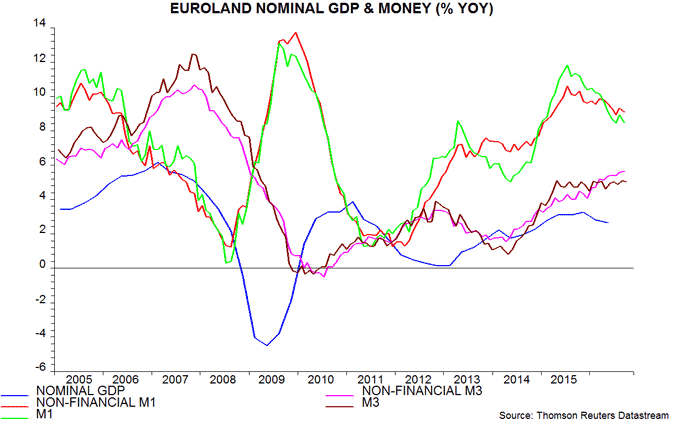
Economic growth prospects depend on real rather than nominal monetary trends. Six-month growth rates of non-financial M1 and M3, deflated by consumer prices, have moderated recently but remain solid by recent and longer-term standards – second chart. The slowdown would need to extend significantly further to suggest weakening prospects, on the judgement here.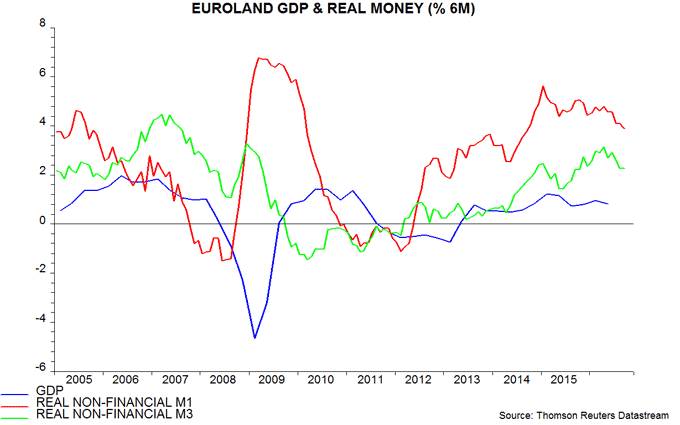
The decline in real narrow money growth has been focused on France and, to a lesser extent, Germany, with Spanish and Italian trends remaining upbeat, based on country data on overnight deposits – third chart. This may signal improving relative economic and equity market prospects for Spain / Italy, and deteriorating reelection prospects for President Hollande.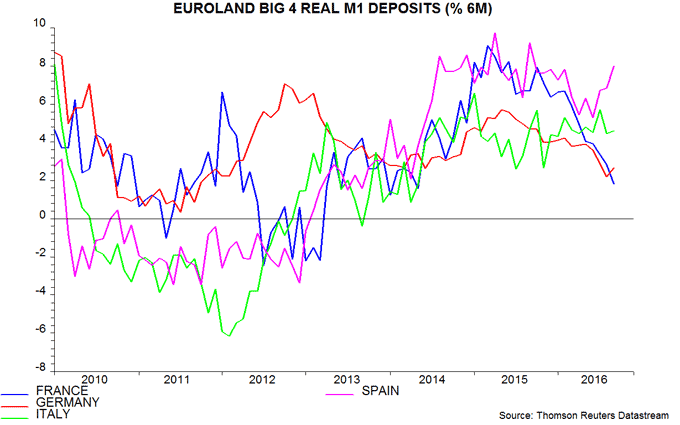
Solid UK Q3 GDP questions MPC easing
The preliminary estimate of a 0.5% rise in GDP in the third quarter raises further doubts about the MPC’s pre- and post-Brexit vote economic analysis and should extinguish any remaining expectations of an additional cut in Bank rate. There is, indeed, a case for suspending the current QE programme to reflect the much stronger economic environment than the MPC expected.
The 0.5% increase compares with a 0.4-0.5% projection here and a consensus estimate of 0.3%. Strong services growth of 0.8% over the quarter offset falls of 0.4% and 1.4% in industrial and construction output. Within services, output of “transport, storage and communications” rose by 2.2%, boosted by strength in creative activities (film, video and TV programme production, sound recording and music publishing). “Business services and finance” and “distribution, hotels and restaurants” also made significant growth contributions.
The preliminary estimate is based on only about 44% of the information that will be incorporated in the final output-based GDP measure. Historically, however, an upward growth revision has been slightly more likely than a downgrade.
Monthly output data underlying the 0.5% growth estimate imply that GDP rose steadily over the three months, with September’s level 0.1% above the quarterly average – see first chart.
GDP rose by 1.2% (2.4% annualised) in the second and third quarters combined, the fastest two-quarter growth since the fourth quarter of 2014. A pick-up in momentum had been suggested by monetary trends: six-month growth rates of real narrow and broad money (as measured by non-financial M1 and M4 deflated by consumer prices) increased in late 2015 / early 2016 – second chart.
The MPC ignored monetary trends and has misread the economy. At its July meeting, the Committee judged that the Brexit vote “was likely to depress economic activity in the near term”. It was more explicit in August, expecting “little growth in GDP during the second half”, with the Bank’s staff forecasting that the preliminary third-quarter estimate would show no change from the second quarter. Better data forced an upgrade in September but the MPC still anticipated “a material slowing of UK GDP growth”, with the staff estimating a preliminary third-quarter rise of only 0.2%.
The MPC can, at least, pass the dunce’s cap to the Treasury, which predicted that GDP would fall by between 0.1% and 1.0% in the third quarter in the event of a Brexit vote.
Global acceleration watch: business surveys
Business surveys generally provide little if any lead on economic developments and sometimes give false signals (e.g. the suggestion from the UK PMIs that output would fall in the wake of the Brexit vote*). They are, however, timely, and can be useful in confirming a change in the economic landscape, particularly when surveys in a number of countries shift simultaneously.
Such a shift appears to be occurring currently – manufacturing surveys strengthened in early October in the US, Japan, Eurozone and UK, consistent with the view here that economic acceleration is under way globally.
In the US, an average** of the new orders components of the New York and Philadelphia Fed manufacturing surveys rose sharply this month, confirming that a September rebound in the ISM new orders index was genuine – see first chart. The orders index of the alternative Markit PMI survey, meanwhile, reached a 12-month high.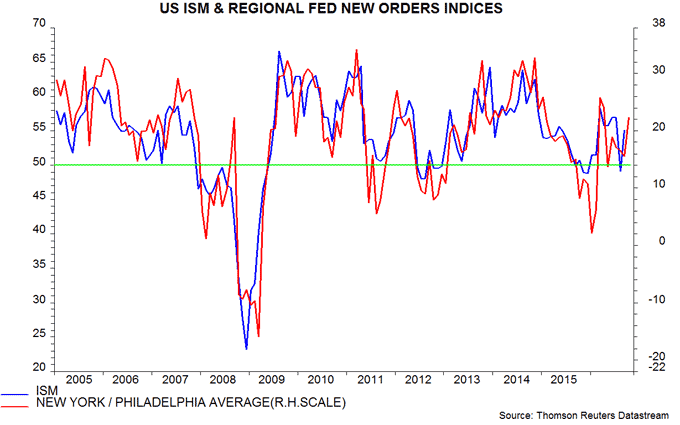
The Markit Japan PMI new orders index weakened sharply as the yen surged during the first half of 2016 but regained the 50 level – implying more firms reporting rises than falls – in October, despite an absence of currency relief. The Eurozone index has remained comfortably in expansionary territory and rose to a four-month high this month – second chart.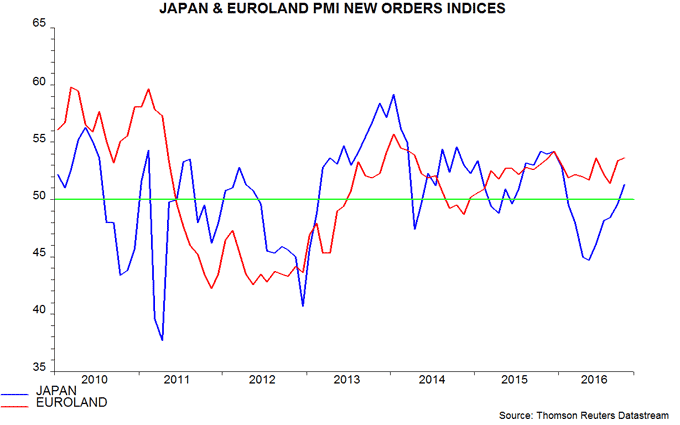
The Eurozone PMI gain was led by strength in Germany, which was confirmed by today’s Ifo survey, showing manufacturing business expectations at their highest since 2014 – third chart.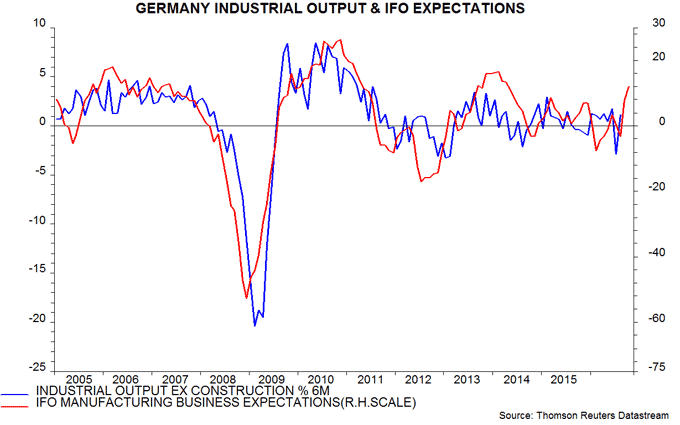
In the UK, the October CBI quarterly industrial survey reported a rebound in the expected domestic orders balance and a surge in export orders – fourth chart***. Before attributing the latter to sterling weakness, it should be noted that the percentage of firms judging pricing to be a constraint on exports was stable over the quarter, questioning Brexiter claims that a lower pound will allow UK exporters to gain market share – fifth chart. 
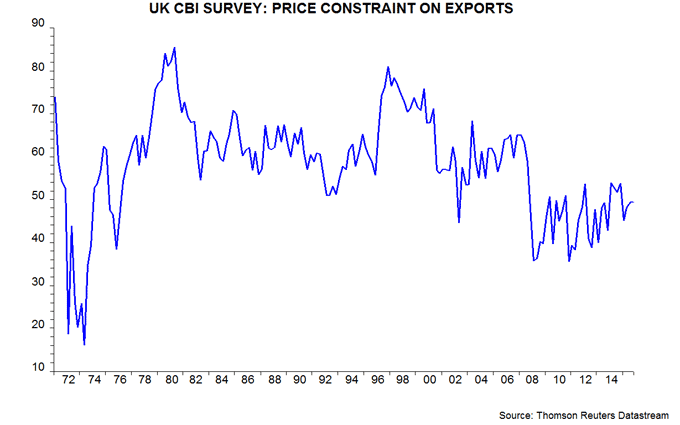 *UK GDP is estimated to have risen by 0.3% between June and July, based on sectoral output data.
*UK GDP is estimated to have risen by 0.3% between June and July, based on sectoral output data.
**Average of current and expected new order balances.
***Seasonal adjustment applied to CBI data.

